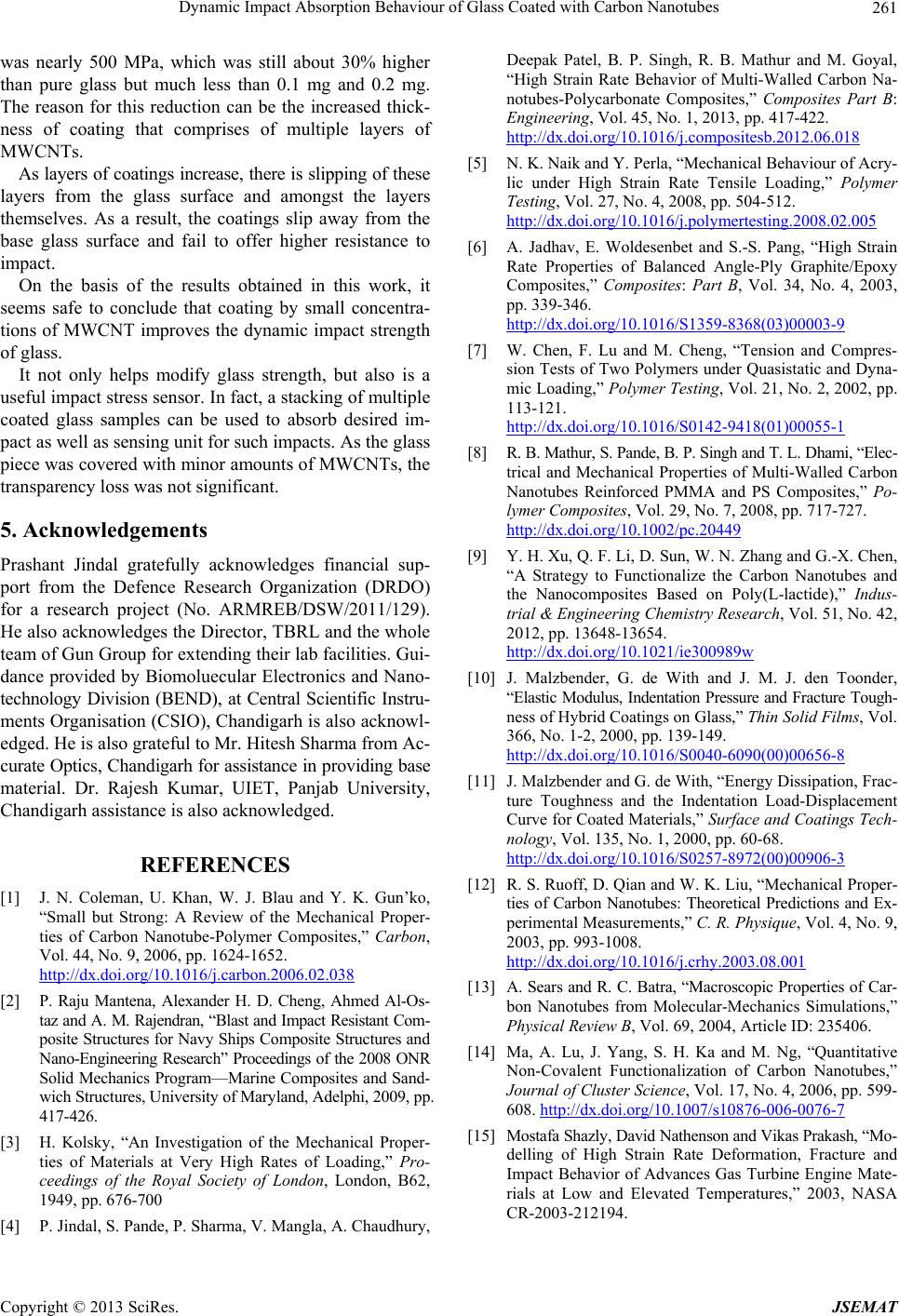
Dynamic Impact Absorption Behaviour of Glass Coated with Carbon Nanotubes 261
was nearly 500 MPa, which was still about 30% higher
than pure glass but much less than 0.1 mg and 0.2 mg.
The reason for this reduction can be the increased thick-
ness of coating that comprises of multiple layers of
MWCNTs.
As layers of coatings increase, there is slipping of these
layers from the glass surface and amongst the layers
themselves. As a result, the coatings slip away from the
base glass surface and fail to offer higher resistance to
impact.
On the basis of the results obtained in this work, it
seems safe to conclude that coating by small concentra-
tions of MWCNT improves the dynamic impact strength
of glass.
It not only helps modify glass strength, but also is a
useful impact stress sensor. In fact, a stacking of multiple
coated glass samples can be used to absorb desired im-
pact as well as sensing unit for such impacts. As the glass
piece was covered with minor amounts of MWCNTs, the
transparency loss was not significant.
5. Acknowledgements
Prashant Jindal gratefully acknowledges financial sup-
port from the Defence Research Organization (DRDO)
for a research project (No. ARMREB/DSW/2011/129).
He also acknowledges the Director, TBRL and the whole
team of Gun Group for extending their lab facilities. Gui-
dance provided by Biomoluecular Electronics and Nano-
technology Division (BEND), at Central Scientific Instru-
ments Organisation (CSIO), Chandigarh is also acknowl-
edged. He is also grateful to Mr. Hitesh Sharma from Ac-
curate Optics, Chandigarh for assistance in providing base
material. Dr. Rajesh Kumar, UIET, Panjab University,
Chandigarh assistance is also acknowledged.
REFERENCES
[1] J. N. Coleman, U. Khan, W. J. Blau and Y. K. Gun’ko,
“Small but Strong: A Review of the Mechanical Proper-
ties of Carbon Nanotube-Polymer Composites,” Carbon,
Vol. 44, No. 9, 2006, pp. 1624-1652.
http://dx.doi.org/10.1016/j.carbon.2006.02.038
[2] P. Raju Mantena, Alexander H. D. Cheng, Ahmed Al-Os-
taz and A. M. Rajendran, “Blast and Impact Resistant Com-
posite Structures for Navy Ships Composite Structures and
Nano-Engineering Research” Proceedings of the 2008 ONR
Solid Mechanics Program—Marine Composites and Sand-
wich Structures, University of Maryland, Adelphi, 2009, pp.
417-426.
[3] H. Kolsky, “An Investigation of the Mechanical Proper-
ties of Materials at Very High Rates of Loading,” Pro-
ceedings of the Royal Society of London, London, B62,
1949, pp. 676-700
[4] P. Jindal, S. Pande, P. Sharma, V. Mangla, A. Chaudhury,
Deepak Patel, B. P. Singh, R. B. Mathur and M. Goyal,
“High Strain Rate Behavior of Multi-Walled Carbon Na-
notubes-Polycarbonate Composites,” Composites Part B:
Engineering, Vol. 45, No. 1, 2013, pp. 417-422.
http://dx.doi.org/10.1016/j.compositesb.2012.06.018
[5] N. K. Naik and Y. Perla, “Mechanical Behaviour of Acry-
lic under High Strain Rate Tensile Loading,” Polymer
Testing, Vol. 27, No. 4, 2008, pp. 504-512.
http://dx.doi.org/10.1016/j.polymertesting.2008.02.005
[6] A. Jadhav, E. Woldesenbet and S.-S. Pang, “High Strain
Rate Properties of Balanced Angle-Ply Graphite/Epoxy
Composites,” Composites: Part B, Vol. 34, No. 4, 2003,
pp. 339-346.
http://dx.doi.org/10.1016/S1359-8368(03)00003-9
[7] W. Chen, F. Lu and M. Cheng, “Tension and Compres-
sion Tests of Two Polymers under Quasistatic and Dyna-
mic Loading,” Polymer Testing, Vol. 21, No. 2, 2002, pp.
113-121.
http://dx.doi.org/10.1016/S0142-9418(01)00055-1
[8] R. B. Mathur, S. Pande, B. P. Singh and T. L. Dhami, “Elec-
trical and Mechanical Properties of Multi-Walled Carbon
Nanotubes Reinforced PMMA and PS Composites,” Po-
lymer Composites, Vol. 29, No. 7, 2008, pp. 717-727.
http://dx.doi.org/10.1002/pc.20449
[9] Y. H. Xu, Q. F. Li, D. Sun, W. N. Zhang and G.-X. Chen,
“A Strategy to Functionalize the Carbon Nanotubes and
the Nanocomposites Based on Poly(L-lactide),” Indus-
trial & Engineering Chemistry Research, Vol. 51, No. 42,
2012, pp. 13648-13654.
http://dx.doi.org/10.1021/ie300989w
[10] J. Malzbender, G. de With and J. M. J. den Toonder,
“Elastic Modulus, Indentation Pressure and Fracture Tough-
ness of Hybrid Coatings on Glass,” Thin Solid Films, Vol.
366, No. 1-2, 2000, pp. 139-149.
http://dx.doi.org/10.1016/S0040-6090(00)00656-8
[11] J. Malzbender and G. de With, “Energy Dissipation, Frac-
ture Toughness and the Indentation Load-Displacement
Curve for Coated Materials,” Surface and Coatings Tech-
nology, Vol. 135, No. 1, 2000, pp. 60-68.
http://dx.doi.org/10.1016/S0257-8972(00)00906-3
[12] R. S. Ruoff, D. Qian and W. K. Liu, “Mechanical Proper-
ties of Carbon Nanotubes: Theoretical Predictions and Ex-
perimental Measurements,” C. R. Physique, Vol. 4, No. 9,
2003, pp. 993-1008.
http://dx.doi.org/10.1016/j.crhy.2003.08.001
[13] A. Sears and R. C. Batra, “Macroscopic Properties of Car-
bon Nanotubes from Molecular-Mechanics Simulations,”
Physical Review B, Vol. 69, 2004, Article ID: 235406.
[14] Ma, A. Lu, J. Yang, S. H. Ka and M. Ng, “Quantitative
Non-Covalent Functionalization of Carbon Nanotubes,”
Journal of Cluster Science, Vol. 17, No. 4, 2006, pp. 599-
608. http://dx.doi.org/10.1007/s10876-006-0076-7
[15] Mostafa Shazly, David Nathenson and Vikas Prakash, “Mo-
delling of High Strain Rate Deformation, Fracture and
Impact Behavior of Advances Gas Turbine Engine Mate-
rials at Low and Elevated Temperatures,” 2003, NASA
CR-2003-212194.
Copyright © 2013 SciRes. JSEMAT